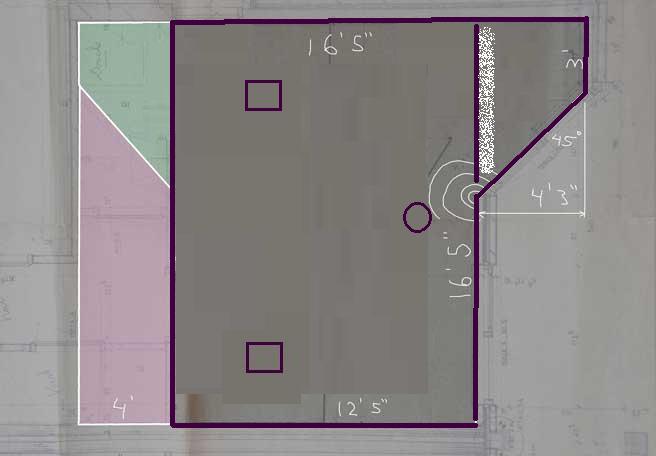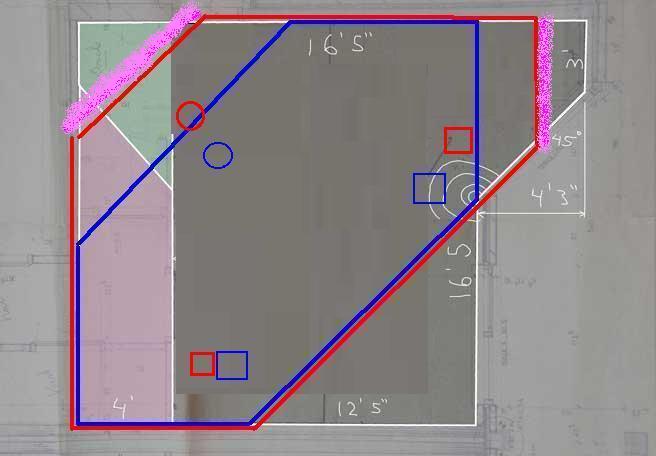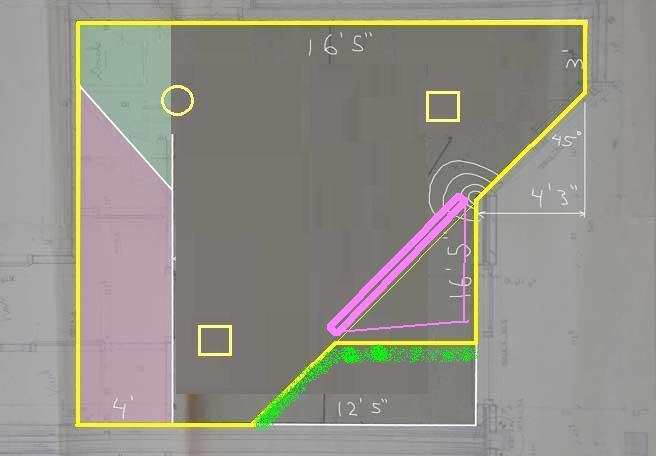Rerurn to Romy the Cat's Site
In the Forum: Playback Listening
In the Thread: Building a new music room
Post Subject: Consider Diagonal Placement/Hexagonal FormPosted by RF at Ona on: 10/18/2007
Collin,
I would suggest that you abandon the idea of placing your speakers against the back wall with that reflecting/diffracting angle in front of the speaker(s). Such a structural intrusion would not be kind to the polar radiation pattern of the loudspeaker-room system. It is not just a matter of the reflections which would reach the listener but the acoustical environment of the loudspeakers would be a mess. You might want to look at Roy Allison's work on the effects of room acoustics on loudspeaker linearity in this regard.
It is far better for that angle to be behind the speakers or the listener. Changing the room structure to create a similar angle on the left side doesn't solve the problem. It's rather like breaking your left arm after you've broken your right for reasons of symmetry. Nor do I think the added space would help much acoustically or visually.
I have had a little experience placing speakers in odd rooms. I lived in a number of studios and small apartments in Manhattan with challenging layouts, particularly during my student years. Some of my more successful placements were along the LONG side instead of the short side of a room. I've had living rooms so elongated that it was the only practical way and I have generally liked the results. I was using, at the time, planar and box speakers - not horns.
My experience with square rooms has never been good and I would avoid expensive alterations from a smaller rectangular to a slightly larger square room unless the placement problems were proven to be vexing.
FIRST DIAGRAM, a conservative approach:

In the first drawing, I suggest a simple sidewall placement (black outline). A non-structural barrier such as tall shelving or cabinetry (white speckle) could be used to tame the odd angled alcove. You could enlarge the room as you indicated but it would take the room toward square - classic trade off between worsening the standing wave colorations but improving the placement issues (more coherent speaker, better early reflection characteristics).
SECOND DIAGRAM, a hexagonal model:

In the second diagram, I show an enlarged room but with a prototypical wide hexagonal room with the speakers placed along the wide side - now nearly diagonal to the original room (blue outline). The hexagonal geometry is nice acoustically. It is symmetric and has improved standing wave characteristics. You can stretch the hexagonal shape to use more of the room (red outline). Note that the short room sides (pink speckle) need not be structural, shelving would do.
The speaker placement is near to the enlarged room's main diagonal and has the effect of both visually and acoustically widening the room.
Try this visual test in a room - stand on the diagonal facing the far corner. Notice how wide the room looks compared with facing a sidewall directly. That room diagonal, with the corners of the room in the visual peripheral field, is a great asset to exploit.
THIRD DIAGRAM, Enlarged room - Diagonal Placement:

In the final diagram, I show a diagonal placement using nearly all the enlarged room (yellow outline). The hexagonal has been stretched to a nearly triangular pentagon. I must say that I have limited experience with such a triangular room shape but it has things to recommend it. In particular you have wide visual and acoustic space without structural interference between the speakers and the listener. There should not be a standing wave problem similar to a square room because the equal length sides are not parallel and there is some irregularity to the shape.
In my diagram, I show the wall behind the speakers with a small alcove for your television (in pink), if it needs depth. The short walls (with green speckle) are non-structural and again could be made with tall shelving or cabinetry.
Because this layout can be tried most directly after the room is fully enlarged, I would probably try it first and possibly work toward a more ideal shape with furniture and acoustical treatments or barriers if needed. However I wanted to show a logical progression from a superior (but smaller) hexagonal geometry to this more practical one.
Best of luck - I hope it all turns out well,
Robert
PS: Where I mention tall shelving or cabinetry isolating a space or acting as a non-structural wall, I am referring to a full floor-to-ceiling acoustical barrier or to filling the space (packed storage). You want to avoid creating a resonant cavity or Helmholtz resonator out of these room pockets.
Rerurn to Romy the Cat's Site